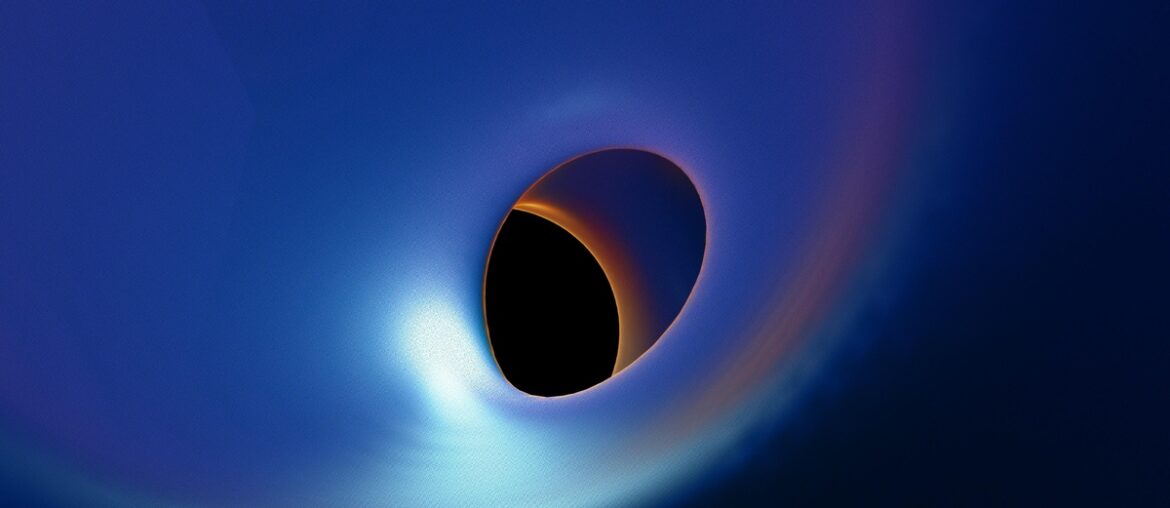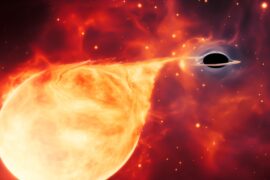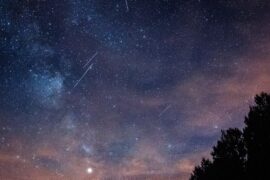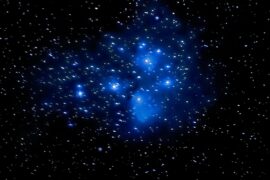Gravitational-wave astronomy has mapped dozens of collisions between black holes, giving us a running record of when and how these extreme events occur across the sky. The list below collects those detections into a single, searchable table for quick comparison.
There are 59 Merging Black Holes, ranging from GW150914 to GW200316_215756. For each entry you’ll find below Detection date (UTC),Masses (M☉),Distance (Mpc).
How were these black hole mergers detected?
Ground-based interferometers (LIGO, Virgo and increasingly KAGRA) measure tiny spacetime ripples produced by merging compact objects; analysts use matched filtering with waveform models to identify events, estimate merger times and extract parameters like component masses and distances, and then compile those results into the catalog you see below.
What do the Masses (M☉) and Distance (Mpc) columns tell me?
Masses are given in solar masses (M☉) and come from waveform fits that report component and/or final masses with uncertainties; distances are typically luminosity distances in megaparsecs (Mpc), inferred from signal amplitude and subject to redshift and calibration uncertainties—use the provided errors to judge confidence.
Merging Black Holes
| Event | Detection date (UTC) | Masses (M☉) | Distance (Mpc) |
|---|---|---|---|
| GW150914 | 2015-09-14 | 35.6, 30.6 | 430 |
| GW151012 | 2015-10-12 | 23.3, 13.6 | 1,050 |
| GW151226 | 2015-12-26 | 13.7, 7.7 | 440 |
| GW170104 | 2017-01-04 | 31.0, 20.1 | 960 |
| GW170608 | 2017-06-08 | 11.0, 7.6 | 320 |
| GW170729 | 2017-07-29 | 50.6, 34.3 | 2,750 |
| GW170809 | 2017-08-09 | 35.2, 23.8 | 1,030 |
| GW170814 | 2017-08-14 | 30.7, 25.3 | 580 |
| GW170818 | 2017-08-18 | 35.5, 26.8 | 1,060 |
| GW170823 | 2017-08-23 | 39.6, 29.4 | 1,850 |
| GW190408_181802 | 2019-04-08 | 24.6, 18.2 | 1,550 |
| GW190412 | 2019-04-12 | 29.8, 8.4 | 740 |
| GW190413_052954 | 2019-04-13 | 33.1, 23.0 | 2,140 |
| GW190413_134308 | 2019-04-13 | 48.2, 11.9 | 3,670 |
| GW190421_213856 | 2019-04-21 | 41.5, 31.9 | 2,400 |
| GW190503_185404 | 2019-05-03 | 42.4, 28.5 | 3,670 |
| GW190512_180714 | 2019-05-12 | 22.0, 14.0 | 1,850 |
| GW190513_205428 | 2019-05-13 | 38.2, 21.6 | 2,940 |
| GW190514_065416 | 2019-05-14 | 28.7, 20.3 | 3,130 |
| GW190517_055101 | 2019-05-17 | 39.8, 31.9 | 4,280 |
| GW190519_153544 | 2019-05-19 | 64.0, 41.0 | 4,810 |
| GW190521 | 2019-05-21 | 85.0, 66.0 | 5,300 |
| GW190521_074359 | 2019-05-21 | 43.1, 33.1 | 3,540 |
| GW190527_092055 | 2019-05-27 | 40.1, 30.6 | 2,780 |
| GW190602_175927 | 2019-06-02 | 69.0, 45.0 | 3,260 |
| GW190620_030421 | 2019-06-20 | 41.0, 31.9 | 2,600 |
| GW190630_185205 | 2019-06-30 | 35.2, 26.6 | 2,060 |
| GW190701_203306 | 2019-07-01 | 53.9, 39.4 | 3,600 |
| GW190706_222641 | 2019-07-06 | 39.9, 29.3 | 3,390 |
| GW190707_093326 | 2019-07-07 | 12.1, 8.2 | 930 |
| GW190708_232457 | 2019-07-08 | 26.3, 16.7 | 1,440 |
| GW190719_215514 | 2019-07-19 | 20.7, 13.5 | 2,400 |
| GW190720_000836 | 2019-07-20 | 13.0, 8.4 | 950 |
| GW190727_060333 | 2019-07-27 | 35.2, 23.3 | 2,870 |
| GW190728_064510 | 2019-07-28 | 12.5, 8.0 | 800 |
| GW190731_140656 | 2019-07-31 | 28.5, 18.2 | 2,950 |
| GW190803_022701 | 2019-08-03 | 47.5, 31.6 | 3,020 |
| GW190828_063405 | 2019-08-28 | 33.1, 25.1 | 1,640 |
| GW190828_065509 | 2019-08-28 | 21.6, 14.8 | 2,060 |
| GW190910_112807 | 2019-09-10 | 45.2, 33.7 | 2,980 |
| GW190915_235702 | 2019-09-15 | 38.2, 29.2 | 2,270 |
| GW190917_114630 | 2019-09-17 | 36.1, 26.6 | 3,030 |
| GW190924_021846 | 2019-09-24 | 9.0, 5.0 | 580 |
| GW190925_232845 | 2019-09-25 | 22.6, 17.5 | 2,400 |
| GW190929_012149 | 2019-09-29 | 34.1, 27.2 | 3,140 |
| GW190930_133541 | 2019-09-30 | 17.6, 10.9 | 1,040 |
| GW200112_155838 | 2020-01-12 | 35.9, 29.0 | 2,140 |
| GW200128_022011 | 2020-01-28 | 42.4, 33.1 | 2,660 |
| GW200129_065458 | 2020-01-29 | 34.0, 22.0 | 1,000 |
| GW200202_154313 | 2020-02-02 | 18.1, 16.2 | 1,740 |
| GW200208_130117 | 2020-02-08 | 28.0, 20.3 | 2,710 |
| GW200209_085452 | 2020-02-09 | 37.8, 29.8 | 2,840 |
| GW200219_094415 | 2020-02-19 | 35.0, 31.2 | 3,370 |
| GW200220_061928 | 2020-02-20 | 37.3, 19.3 | 3,430 |
| GW200224_222234 | 2020-02-24 | 40.1, 31.8 | 2,060 |
| GW200225_060421 | 2020-02-25 | 18.9, 14.8 | 1,510 |
| GW200302_015811 | 2020-03-02 | 20.7, 16.5 | 2,400 |
| GW200311_115853 | 2020-03-11 | 34.0, 28.0 | 2,210 |
| GW200316_215756 | 2020-03-16 | 25.1, 16.8 | 1,730 |
Images and Descriptions
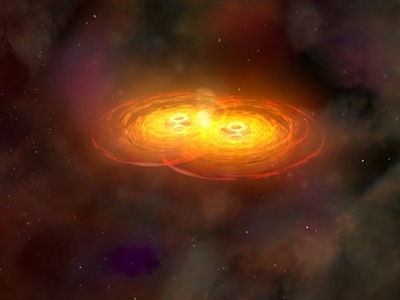
GW150914
The historic first-ever direct detection of gravitational waves. This monumental event confirmed a key prediction of Einstein’s general relativity and opened an entirely new way to observe the universe, revealing two massive black holes merging.
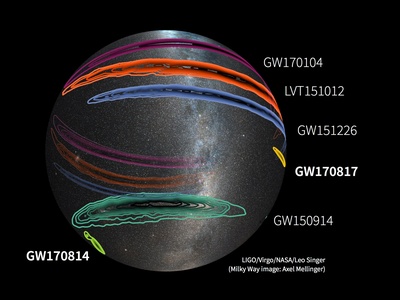
GW151012
The second confident gravitational-wave detection, confirming that such events were not a one-off fluke. This merger involved two mid-sized black holes, helping astronomers begin to understand the population of these exotic objects in the cosmos.

GW151226
Nicknamed “the Boxing Day event,” this was the first detection of a lower-mass black hole binary. At least one of the black holes was observed spinning, providing the first clear evidence of spin in a merging system.
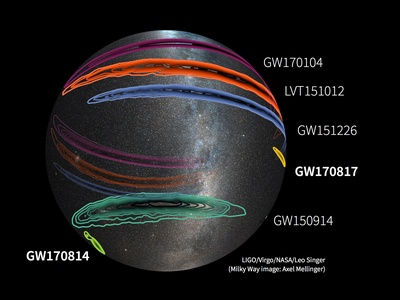
GW170104
This event confirmed that black hole spins can be misaligned with their orbital plane, suggesting they might form dynamically in dense star clusters rather than evolving together as an isolated pair. The merger created a black hole of about 49 solar masses.

GW170608
At the time, this was the lightest binary black hole system ever detected. Its relatively close proximity and lower mass allowed for a very precise measurement, offering a valuable data point for understanding the lower end of the black hole mass spectrum.
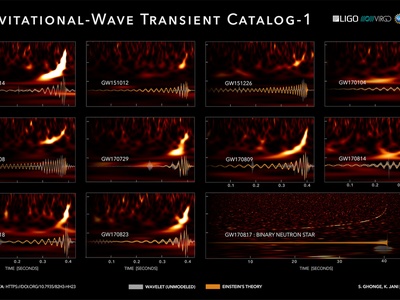
GW170729
One of the most massive and distant binary black hole mergers detected during the second observing run. The resulting black hole was about 80 times the mass of the sun, making it the heaviest remnant observed up to that point.
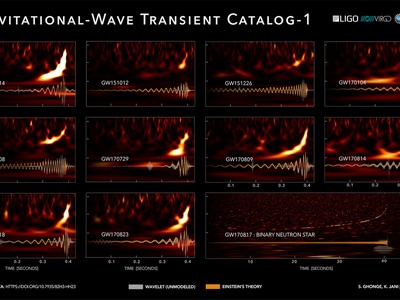
GW170809
This merger was detected with good precision, helping to constrain the properties of the black holes, particularly their spins. The data supported the idea that black holes can have a wide range of spin orientations relative to their orbit.

GW170814
The first gravitational-wave signal observed by all three detectors (LIGO Hanford, LIGO Livingston, and Virgo). The addition of Virgo greatly improved the ability to locate the event’s position in the sky, shrinking the search area by over a factor of 10.
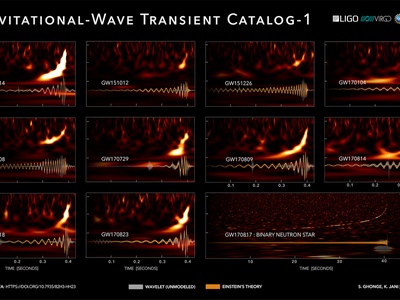
GW170818
Another solid detection of a mid-range binary black hole system. This event contributed to the growing catalog, helping astronomers build statistical models of black hole populations, their masses, and their merger rates throughout the universe.
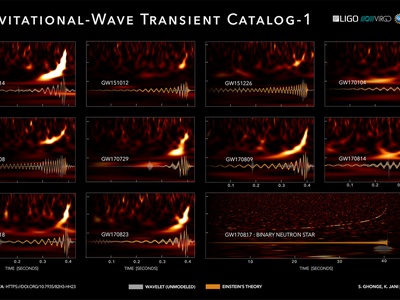
GW170823
The final binary black hole merger detected during the second observing run (O2). Its properties were typical for the systems seen so far, adding another important data point to the catalog before the detectors were shut down for upgrades.

GW190408_181802
One of the first detections of the third observing run (O3). This event was a fairly standard mid-mass merger but was notable for having a significantly unequal mass ratio compared to most previous detections, hinting at diverse formation channels.

GW190412
A landmark detection of a binary with a distinctly unequal mass ratio of about 3.5-to-1. This asymmetry produced higher-order gravitational wave harmonics, which were detected for the first time, allowing for new tests of general relativity.

GW190413_052954
A typical binary black hole merger from the O3 run, adding to the growing statistics of these cosmic collisions. Such “standard” detections are crucial for refining our understanding of how often these events occur and the typical masses involved.

GW190413_134308
A distant and massive merger event. The significant difference in the masses of the two black holes made it an interesting system for studying the dynamics of unequal-mass mergers and the gravitational waves they produce.

GW190421_213856
This merger involved two heavy stellar-mass black holes. Events like this are valuable for understanding the upper limits of black hole masses formed from stellar collapse and the environments that can produce such massive binary systems.

GW190503_185404
A powerful merger between two large black holes, releasing a tremendous amount of energy in gravitational waves. Its detection from such a great distance showcases the incredible sensitivity achieved by the detector network during the O3 run.

GW190512_180714
A mid-range black hole merger that helps fill out the mass distribution of these systems. The accumulation of such events is critical for understanding the life cycles of massive stars and the formation of binary systems.

GW190513_205428
Another significant detection from the prolific O3 run. This event involved a fairly unequal mass ratio, contributing to the study of how such asymmetric binaries form and what their gravitational wave signatures look like.

GW190514_065416
A distant merger of two intermediate-mass black holes. The consistent detection of such events provides strong evidence for a healthy population of black holes in this mass range, helping to constrain theories of stellar evolution.

GW190517_055101
One of the more distant detections from the first half of O3. Its signal traveled for billions of years before reaching Earth, offering a glimpse into the universe’s violent past and the evolution of black hole populations over cosmic time.

GW190519_153544
A merger of two very heavy black holes, one of which was potentially in the “upper mass gap” where black holes are not expected to form from single stars. This hints at hierarchical mergers, where black holes merge multiple times.
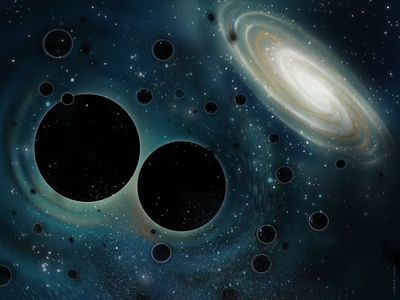
GW190521
The most massive binary black hole merger ever observed. It formed an intermediate-mass black hole of about 142 solar masses, the first of its kind ever detected. This event challenges our understanding of how both stellar and supermassive black holes form.

GW190521_074359
Not to be confused with the famous massive GW190521 event on the same day, this was a more conventional merger. It highlights the increasing detection rate, where multiple events can be recorded in a single 24-hour period.

GW190527_092055
A solid mid-range detection that adds to the growing family of binary black hole mergers. These events, while less spectacular than record-breakers, form the statistical backbone needed to test theories of stellar and binary evolution.

GW190602_175927
A merger of two very heavy stellar-mass black holes, similar to GW190519. Both components push the upper limits of what is thought possible from a single stellar collapse, suggesting a formation history involving previous mergers or exotic stellar physics.

GW190620_030421
This event involved two massive black holes spiraling together in a distant galaxy. The properties of the resulting gravitational waves help astronomers test the predictions of general relativity under the most extreme conditions of gravity.

GW190630_185205
A confidently detected merger that fits well within the expected mass range for binary black holes. Its signal contributes to the overall catalog used to map the distribution of black hole masses across the universe.

GW190701_203306
A merger of two heavy black holes, with at least one component potentially formed through a previous merger event. Studying such systems is key to understanding how black holes grow and evolve in dense cosmic environments like globular clusters.

GW190706_222641
A powerful cosmic collision that sent ripples through spacetime. The characteristics of the signal allowed for detailed measurements of the final black hole’s mass and spin, providing a precise test of Einstein’s equations.

GW190707_093326
One of the lower-mass systems detected during O3. Observing these lighter black holes is just as important as the heavy ones, as they help complete the full picture of the black hole population and their formation mechanisms.

GW190708_232457
A standard, but valuable, detection of a binary black hole system. Every new event improves the statistical sample, allowing for more precise measurements of the cosmic merger rate and the distribution of black hole properties.

GW190719_215514
This merger involved two relatively light black holes. The continued detection of systems in this mass range helps to constrain the physics of supernova explosions that create black holes, as well as the dynamics of binary star evolution.

GW190720_000836
A relatively nearby and low-mass event. Its stronger signal allowed for more precise parameter estimation, making it a valuable data point for studying the properties of black holes at the lower end of the mass spectrum.

GW190727_060333
A mid-range binary black hole merger that adds to the growing statistical ensemble. These “typical” events are the bedrock of gravitational-wave population studies, helping to reveal trends in black hole masses, spins, and merger rates.

GW190728_064510
This event was one of the best-localized binary black hole mergers at the time of its detection, thanks to signals in all three detectors. Precise sky localization is a key goal for enabling follow-up searches with conventional telescopes.

GW190731_140656
This detection contributes to the growing census of stellar-mass black hole binaries. The consistent observation of these systems provides strong constraints on how massive stars live, die, and form binary pairs that eventually merge.

GW190803_022701
A merger of two significantly massive black holes. Events like this probe the upper end of the stellar-mass black hole spectrum and provide clues about the extreme physics of the massive stars that formed them.

GW190828_063405
A confidently detected merger with properties that are common among the observed population. Its signal helps refine our understanding of the “standard” binary black hole system and the astrophysical processes that create them.

GW190828_065509
The second of two distinct mergers detected on this date, showcasing the high rate of detections during O3. Observing multiple events in a day emphasizes the sheer number of these cosmic collisions happening throughout the universe.

GW190910_112807
A merger between two heavy black holes. The gravitational waves from this event carried away the equivalent of several solar masses in pure energy, warping the fabric of spacetime as they traveled across the cosmos.

GW190915_235702
This event involved a pair of massive black holes in a distant galaxy. The analysis of its signal provided another precise test of general relativity’s predictions about how black holes behave when they merge.

GW190917_114630
Another valuable addition to the O3 catalog. The consistent properties of events like this help to build a robust statistical picture of the universe’s black hole population, refining our models of stellar and galactic evolution.

GW190924_021846
A significant detection of a very low-mass binary black hole system. The secondary component, at only about 5 solar masses, is one of the lightest black holes ever observed with gravitational waves, probing the boundary between neutron stars and black holes.

GW190925_232845
A mid-range black hole merger whose signal contributes to the growing body of evidence about how these systems form. Each detection helps to narrow down the possibilities, from isolated binary evolution to dynamic capture in dense star clusters.

GW190929_012149
A powerful merger from a distant galaxy. The energy released by this single event in gravitational waves for a fraction of a second was more than all the light emitted by all the stars in the observable universe at that moment.

GW190930_133541
A merger of two relatively light black holes. The increasing number of detections in this mass range provides crucial information about the progenitors of these systems and the supernova mechanisms that create them.

GW200112_155838
A strong signal from a classic binary black hole merger. This event adds to the statistical weight of the O3 catalog, helping to confirm the trends in mass and distance observed throughout the run.

GW200128_022011
Another merger of two heavy stellar-mass black holes. The consistency of these detections reinforces our understanding of the universe’s capacity to produce massive stars that collapse into black holes and eventually merge.

GW200129_065458
A highly significant event notable for its precessing orbit, where the orbital plane wobbles like a spinning top. This was one of the clearest examples of precession seen, providing rich information about the black holes’ misaligned spins.

GW200202_154313
A merger of two nearly equal-mass black holes. Symmetrical systems like this provide a clean signal for testing general relativity and for understanding the physics of the merger itself, including the properties of the final remnant black hole.

GW200208_130117
A solid detection that contributes to the ever-growing catalog of binary black hole mergers. These events are the bread and butter of gravitational-wave astronomy, providing the statistical power to uncover the secrets of the dark universe.

GW200209_085452
This event involved two massive black holes whose merger sent powerful gravitational waves across the cosmos. The properties of the signal fit well with the predictions of Einstein’s theory for the inspiral and merger of such a binary system.

GW200219_094415
A merger of two nearly equal and massive black holes. The high mass and symmetry of the system produced a powerful, clean signal, making it an excellent case for studying the fine details of the merger process.

GW200220_061928
This merger was notable for its relatively unequal mass ratio. Such systems are astrophysically interesting as they can tell us more about the formation environments of binaries and provide stronger tests of the underlying theory of gravity.

GW200224_222234
A loud and clear signal from the merger of two massive black holes. Its high signal-to-noise ratio allowed for very precise measurements of the system’s properties, making it a “gold-plated” event for astrophysical analysis.

GW200225_060421
A standard binary black hole merger that helps populate the middle of the mass distribution. Every such event sharpens our view of the black hole population, revealing its overall shape and features.

GW200302_015811
This detection contributes to the third observing run’s impressive haul of black hole mergers. The rapid pace of discovery during O3 transformed the field from discovering rare events to performing population statistics.

GW200311_115853
A merger of two massive black holes whose signal provided another strong confirmation of general relativity. The waveform matched the theoretical templates with remarkable accuracy, confirming our understanding of how spacetime behaves in extreme gravity.

GW200316_215756
A classic binary black hole inspiral and merger. The detection of this and other similar events allows scientists to map the distribution of black holes in the universe and calculate their merger rate with increasing precision.
Enjoyed this article?
Get daily 10-minute PDFs about astronomy to read before bed!
Sign up for our upcoming micro-learning service where you will learn something new about space and beyond every day while winding down.

